Spatiotemporal Analysis of Urban Mobility Using Aggregate Mobile Phone Derived Presence and Demographic Data: A Case Study in the City of Rome, Italy
Abstract
1. Introduction
2. Data
2.1. Description of Studied Area
2.2. Population Data Derived by Mobile Phone Traffic
2.3. Census Statistical Data
3. Data Analysis and Processing
3.1. Time Series of Total Population and Comparison with Census Data
3.2. Definition of a Normalized Population Mobility Factor
3.3. Classification of Daily Mobility Patterns
3.4. Processing of Demographic Data
3.5. Processing of Economic Activities Census Data
4. Results
4.1. Spatial Characteristics of Census Data
4.2. Temporal and Spatial Characteristics of Classified Population Mobility Patterns
4.3. Effect of Population Mobility on Demography
4.4. Connection of Mobility Patterns with the Economic Structure
5. Discussion
6. Conclusions
Supplementary Materials
Author Contributions
Funding
Acknowledgments
Conflicts of Interest
References
- Pucci, P.; Manfredini, F.; Tagliolato, P. Mapping Urban Practices Through Mobile Phone Data; Springer Briefs in Applied Science and Technology; Springer: Cham, Switzerland; Heidelberg, Germany; New York, NY, USA; Dordrecht, The Netherlands; London, UK, 2015. [Google Scholar]
- Ratti, C.; Frenchman, D.; Pulselli, R.M.; Williams, S. Mobile landscapes: Using location data from cell phones for urban analysis. Environ. Plan. B Plan. Des. 2006, 33, 727–748. [Google Scholar] [CrossRef]
- Reades, J.; Calabrese, F.; Sevtsuk, A.; Ratti, C. Cellular census: Explorations in urban data collection. IEEE Pervasive Comput. 2007, 6, 30–38. [Google Scholar] [CrossRef]
- Steenbruggen, J.; Tranos, E.; Nijkamp, P. Data from mobile phone operators: A tool for smarter cities? Telecommun. Policy 2015, 39, 335–346. [Google Scholar] [CrossRef]
- Wang, Z.; He, S.Y.; Leung, Y. Applying mobile phone data to travel behaviour research: A literature review. Travel Behav. Soc. 2018, 11, 141–155. [Google Scholar] [CrossRef]
- Calabrese, F.; Ferrari, L.; Blondel, V.D. Urban Sensing Using Mobile Phone Network Data: A Survey of Research. ACM Comput. Surv. 2014, 47, 25. [Google Scholar] [CrossRef]
- Ahas, R.; Aasa, A.; Yuan, Y.; Raubal, M.; Smoreda, Z.; Liu, Y.; Ziemlicki, C.; Tiru, M.; Zook, M. Everyday space–time geographies: Using mobile phone-based sensor data to monitor urban activity in Harbin, Paris, and Tallinn. Int. J. Geogr. Inf. Sci. 2015. [Google Scholar] [CrossRef]
- Sevtsuk, A.; Ratti, C. Does urban mobility have a daily routine? Learning from aggregate data of mobile networks. J. Urban Technol. 2010, 17, 41–60. [Google Scholar] [CrossRef]
- Demissie, M.G.; de Almeida Correia, G.H.; Bento, C. Exploring cellular network handover information for urban mobility analysis. J. Transp. Geogr. 2013, 31, 164–170. [Google Scholar] [CrossRef]
- Isaacman, S.; Becker, R.; Càceres, R.; Kobourov, S.; Martonosi, M.; Rowland, J.; Varshavsky, A. Ranges of human mobility in Los Angeles and New York. In Proceedings of the Ninth Annual IEEE International Conference on Pervasive Computing and Communications—PerCom 2011, Seattle, WA, USA, 21–25 March 2011. [Google Scholar]
- Gonzàlez, M.C.; Hidalgo, C.; Barabàsi, A. Understanding individual human mobility pattern. Nature 2008, 453. [Google Scholar] [CrossRef] [PubMed]
- Isaacman, S.; Becker, R.; Càceres, R.; Kobourov, S.; Martonosi, M.; Rowland, J.; Varshavsky, A.; Willinger, W. Human mobility modeling at metropolitan scales. In Proceedings of the 10th International Conference on Mobile Systems, Applications, and Services; ACM: New York, NY, USA, 2012. [Google Scholar]
- Widhalm, P.; Yang, Y.; Ulm, M.; Athavale, S.; González, M.C. Discovering urban activity patterns in cell phone data. Transportation 2015, 42, 597–623. [Google Scholar] [CrossRef]
- Secchi, P.; Vantini, S.; Vitelli, V. Analysis of spatio-temporal mobile phone data: A case study in the metropolitan area of Milan. Stat. Methods Appl. 2015, 24, 279–300. [Google Scholar] [CrossRef]
- Phithakkitnukoon, S.; Smoreda, Z.; Olivier, P. Socio-geography of human mobility: A study using longitudinal mobile phone data. PLoS ONE 2012, 7, e39253. [Google Scholar] [CrossRef] [PubMed]
- Deville, P.; Linard, C.; Martin, S.; Gilbert, M.; Stevens, F.R.; Gaughan, A.E.; Blodel, V.D.; Tatem, A.J. Dynamic population mapping using mobile phone data. Proc. Natl. Acad. Sci. USA 2014, 11, 15888–15893. [Google Scholar] [CrossRef] [PubMed]
- Fang, Z.; Yang, X.; Xu, Y.; Shaw, S.L.; Yin, L. Spatiotemporal model for assessing the stability of urban human convergence and divergence patterns. Int. J. Geogr. Inf. Sci. 2017, 31, 2119–2141. [Google Scholar] [CrossRef]
- Yang, X.; Zhao, Z.; Lu, S. Exploring Spatial-Temporal Patterns of Urban Human Mobility Hotspots. Sustainability 2016, 8, 674. [Google Scholar] [CrossRef]
- Yang, X.; Fang, Z.; Xu, Y.; Shaw, S.-L.; Zhao, Z.; Yin, L.; Zhang, T.; Lin, Y. Understanding Spatiotemporal Patterns of Human Convergence and Divergence Using Mobile Phone Location Data. ISPRS Int. J. Geo-Inf. 2016, 5, 177. [Google Scholar] [CrossRef]
- Yuan, Y.; Raubal, M. Extracting Dynamic Urban Mobility Patterns from Mobile Phone Data. In GIScience 2012: Geographic Information Science; Lecture Notes in Computer Science; Xiao, N., Kwan, M.P., Goodchild, M.F., Shekhar, S., Eds.; Springer: Berlin/Heidelberg, Germany, 2012; Volume 7478. [Google Scholar]
- Kang, C.; Sobolevsky, S.; Liu, Y.; Ratti, C. Exploring Human Movements in Singapore: A Comparative Analysis Based on Mobile Phone and Taxicab Usages. In Proceedings of the 2nd International Workshop on Urban Computing (UrbComp’13), Chicago, IL, USA, 11 August 2013. [Google Scholar]
- Sun, J.B.; Yuan, J.; Wang, Y.; Si, H.B.; Shan, X.M. Exploring space–time structure of human mobility in urban space. Phys. A 2011, 390, 929–942. [Google Scholar] [CrossRef]
- Xu, Y.; Shaw, S.; Zhao, Z.; Yin, L.; Fang, Z.; Li, Q. Understanding Aggregate Human Mobility Patterns using Passive Mobile Phone Location Data—A Home-based Approach. Transportation 2015, 42, 625–646. [Google Scholar] [CrossRef]
- Lee, K.S.; You, S.Y.; Eom, J.K.; Song, J.; Min, J.H. Urban spatiotemporal analysis using mobile phone data: Case study of medium- and large-sized Korean cities. Habitat Int. 2018, 73, 6–15. [Google Scholar] [CrossRef]
- Jiang, S.; Ferreira, J.; Gonzalez, M.C. Activity-Based Human Mobility Patterns Inferred from Mobile Phone Data: A Case Study of Singapore. IEEE Trans. Big Data 2017, 3, 208–219. [Google Scholar] [CrossRef]
- Fan, Z.; Pei, T.; Ma, T.; Du, Y.; Song, C.; Liu, Z.; Zhou, C. Estimation of urban crowd flux based on mobile phone location data: A case study of Beijing, China. Comput. Environ. Urban Syst. 2018, 69, 114–123. [Google Scholar] [CrossRef]
- Calabrese, F.; Colonna, M.; Lovisolo, P.; Parata, D.; Ratti, C. Real-time urban monitoring using cell phones: A case study in Rome. IEEE Trans. Intell. Transp. Syst. 2011, 12, 141–151. [Google Scholar] [CrossRef]
- Trasarti, R.; Olteanu-Raimond, A.; Nanni, M.; Couronnè, T.; Furletti, B.; Giannotti, F.; Smoreda, Z.; Ziemlicki, C. Discovering urban and country dynamics from mobile phone data with spatial correlation patterns. Telecommun. Policy 2015, 39, 347–362. [Google Scholar] [CrossRef]
- Furletti, B.; Trasarti, R.; Cintia, P.; Gabrielli, L. Discovering and Understanding City Events with Big Data: The Case of Rome. Information 2017, 8, 74. [Google Scholar] [CrossRef]
- Manfredini, F.; Tagliolato, P.; Di Rosa, C. Monitoring temporary populations through cellular core network data. In Proceedings of the 11th International Conference on Computational Science and Its Applications, Santander, Spain, 20–23 June 2011; Springer: Berlin/Heidelberg, Germany, 2011; Volume Part II, pp. 151–161, ISBN 978-3-642-21887-3. [Google Scholar]
- Soto, V.; Frias-Martinez, E. Robust land use characterization of urban landscapes using cell phone data. In Proceedings of the First Workshop on Pervasive Urban Applications PURBA 2011, San Francisco, CA, USA, 12–15 June 2011. [Google Scholar]
- Isaacman, S.; Becker, R.; Càceres, R.; Kobourov, S.; Martonosi, M.; Rowland, J.; Varshavsky, A. Identifying important places in people’s lives from cellular network data. In Proceedings of the 9th International Conference on Pervasive Computing, San Francisco, CA, USA, 12–15 June 2011. [Google Scholar]
- Gabrielli, L.; Furletti, B.; Trasarti, R.; Giannotti, F.; Pedreschi, D. City users’ classification with mobile phone data. In Proceedings of the 2015 IEEE International Conference on Big Data, Santa Clara, CA, USA, 9 October–1 November 2015; pp. 1007–1012. [Google Scholar]
- Traag, V.A.; Browet, A.; Calabrese, F.; Morlot, F. Social event detection in massive mobile phone data using probabilistic location inference. In Proceedings of the 2011 IEEE Third International Conference on Privacy, Security, Risk and Trust and 2011 IEEE Third International Conference on Social Computing, Boston, MA, USA, 9–11 October 2011. [Google Scholar]
- Gariazzo, C.; Pelliccioni, A.; Bolignano, A. A dynamic urban air pollution population exposure assessment study using model and population density data derived by mobile phone traffic. Atmos. Environ. 2016, 131, 289–300. [Google Scholar] [CrossRef]
- ISTAT. Matrici di Pendolarismo ISTAT. 2014. Available online: http://www.istat.it/it/archivio/139381 (accessed on 7 January 2019). (In Italian).
- ISTAT. Censimento Dell’industria e dei Servizi. 2011. Available online: http://dati-censimentoindustriaeservizi.istat.it/Index.aspx (accessed on 7 January 2019). (In Italian).
- ISTAT. Popolazione e Famiglie. 2016. Available online: https://www.istat.it/it/popolazione-e-famiglie?dati (accessed on 7 January 2019). (In Italian).
- Cesaroni, G.; Agabiti, N.; Rosati, R.; Forastiere, F.; Perucci, C.A. An index of socioeconomic position based on 2001 Census, Rome. Epidemiol. Prev. 2006, 30, 352–357. (In Italian) [Google Scholar]
- Blumenstock, J.E. Fighting poverty with data. Science 2016, 353. [Google Scholar] [CrossRef]
- Pappalardo, L.; Vanhoof, M.; Gabrielli, L.; Smoreda, Z.; Pedreschi, D.; Giannotti, F. An analytical framework to nowcast well-being using mobile phone data. Int. J. Data Sci. Anal. 2016, 2, 75–92. [Google Scholar] [CrossRef]
- Marchetti, S.; Giusti, C.; Pratesi, M.; Salvati, N.; Giannotti, F.; Pedreschi, D.; Rinzivillo, S.; Pappalardo, L.; Gabrielli, L. Small area model-based estimators using Big Data sources. J. Off. Stat. 2015, 31, 263–281. [Google Scholar] [CrossRef]
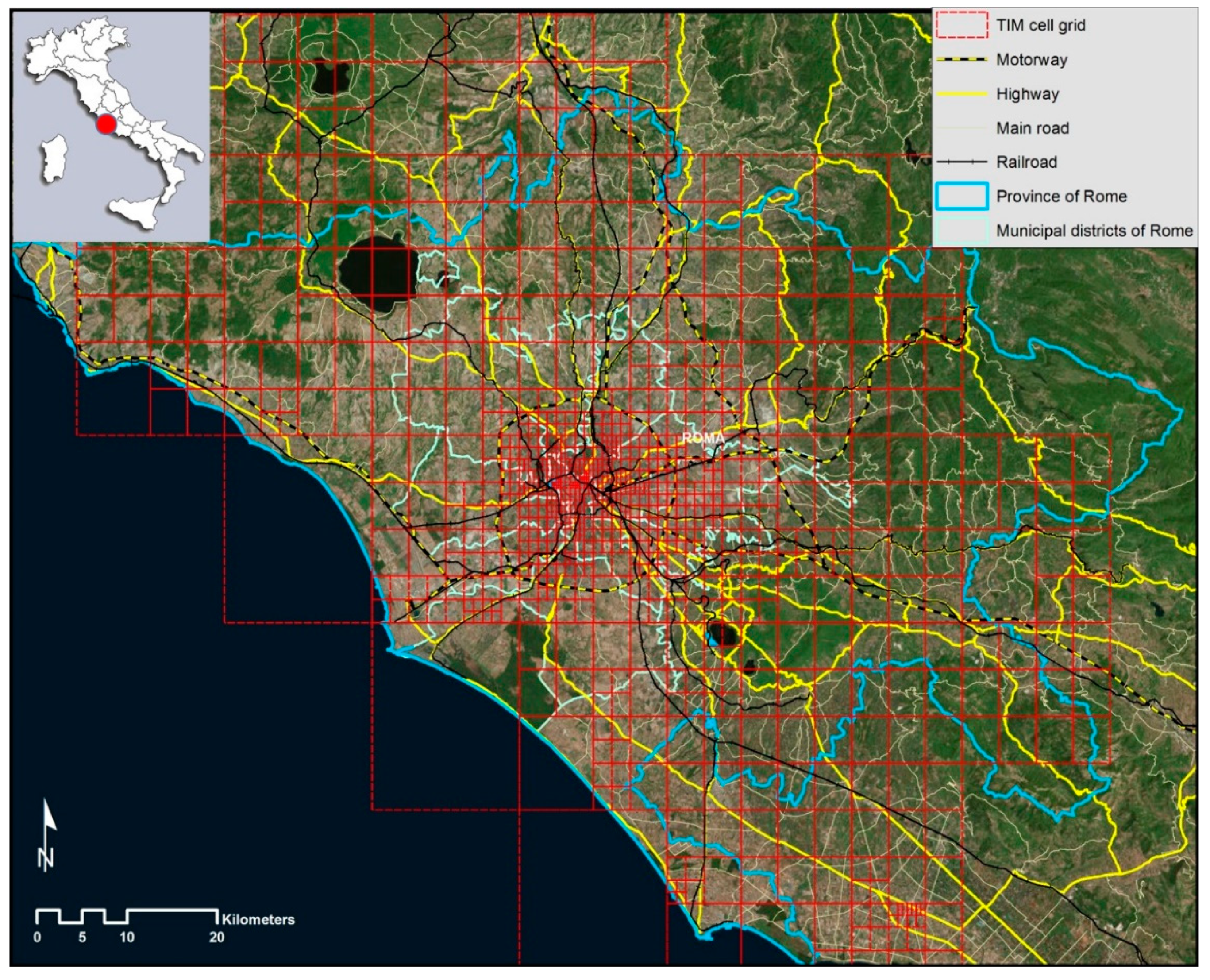
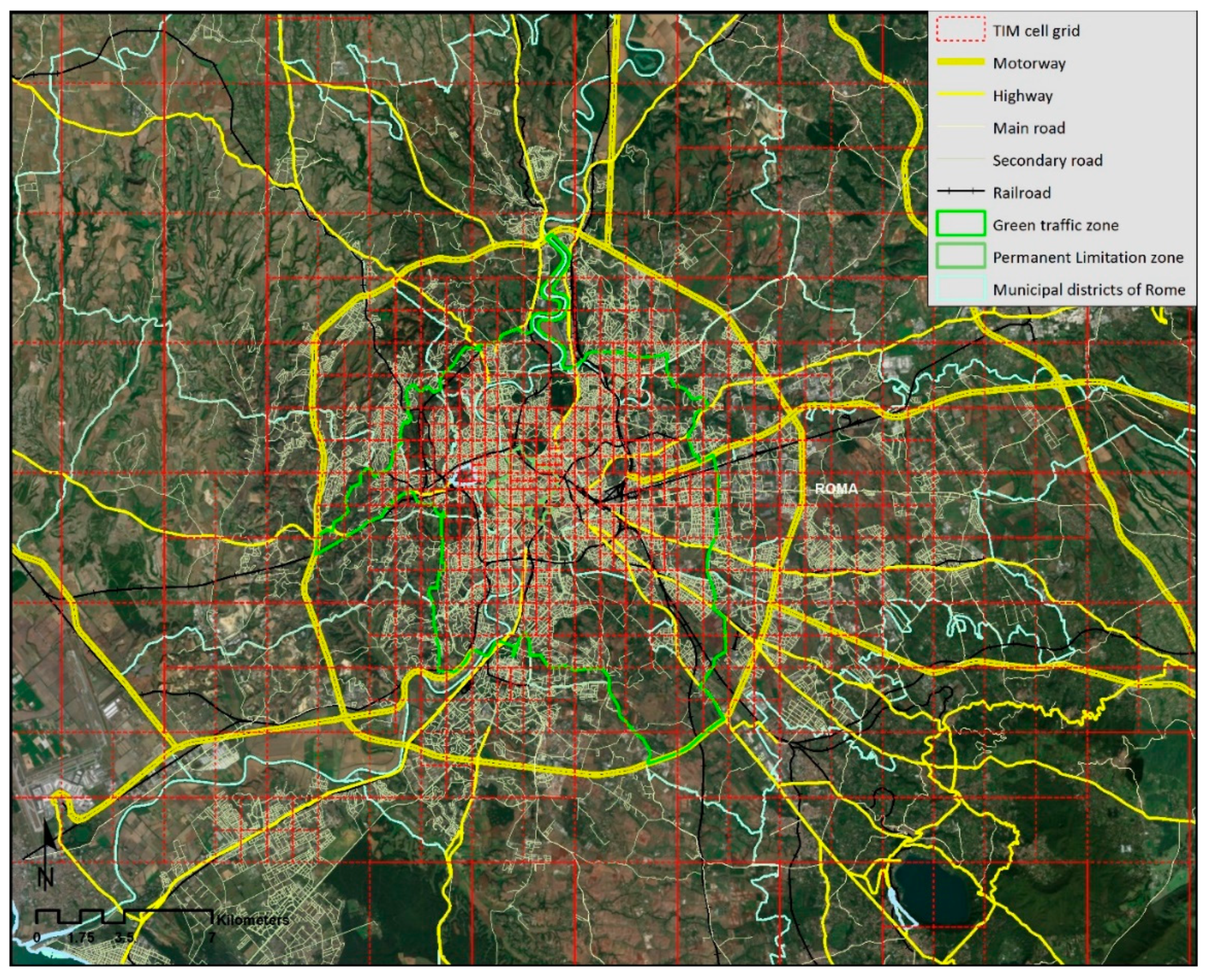
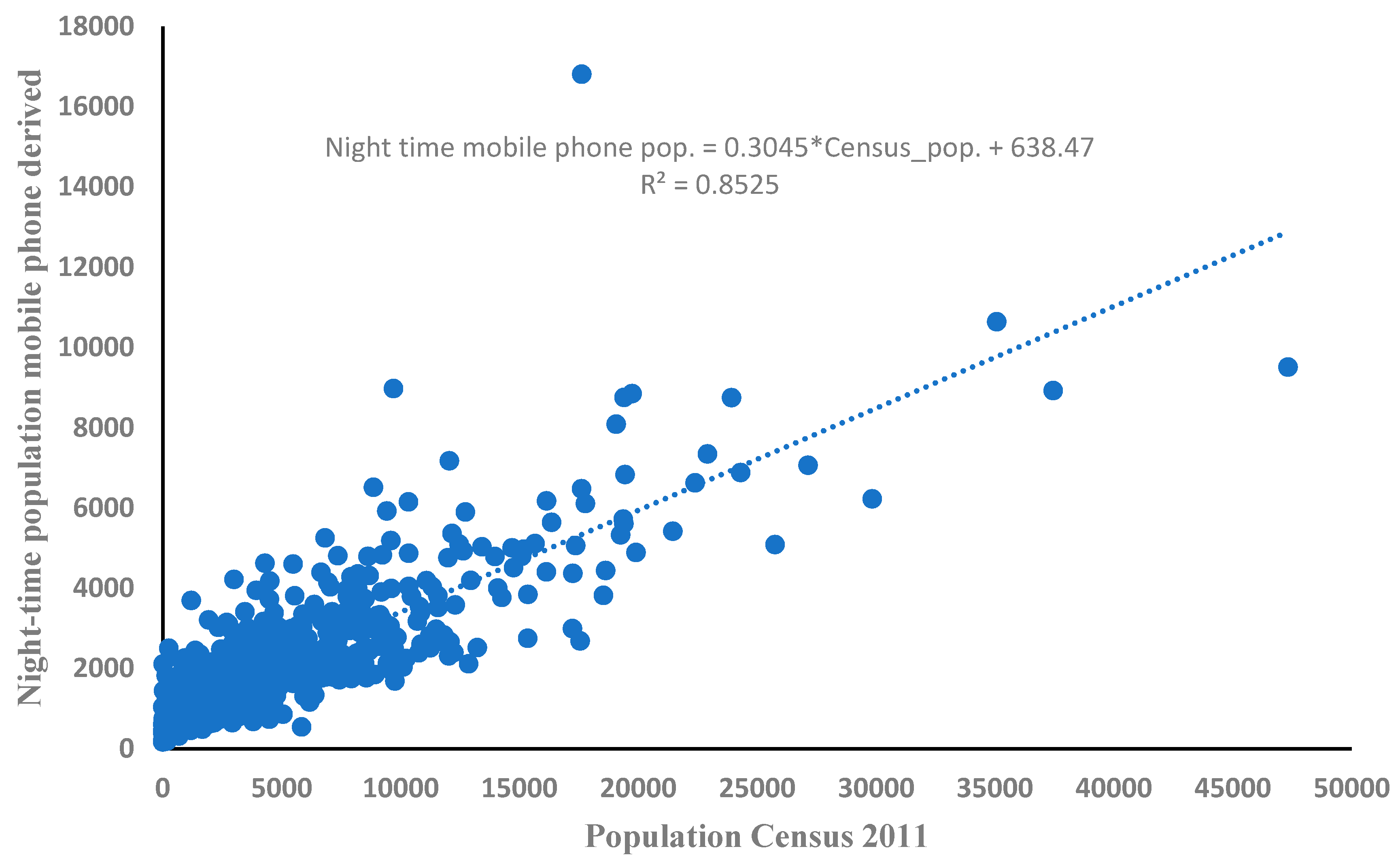
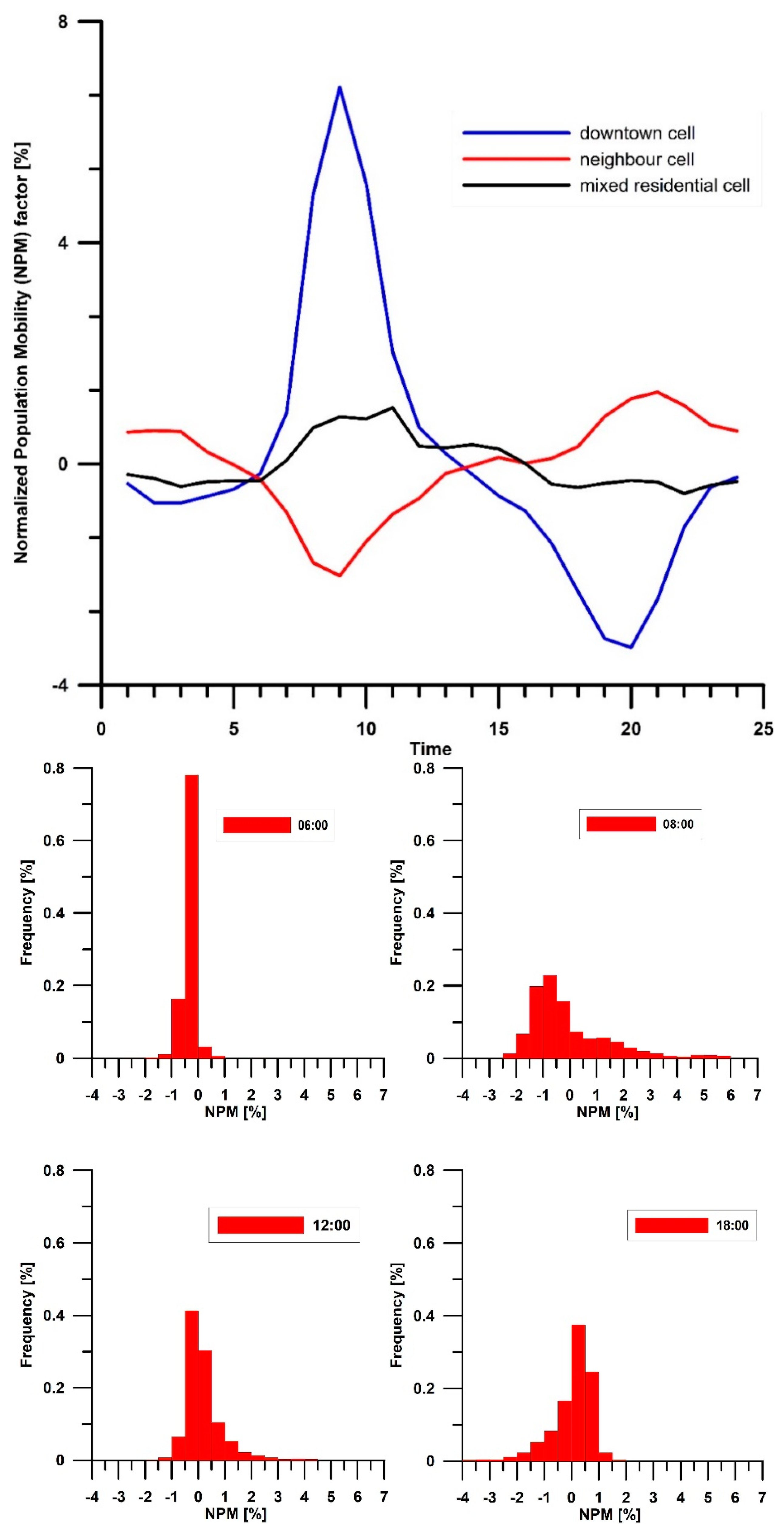
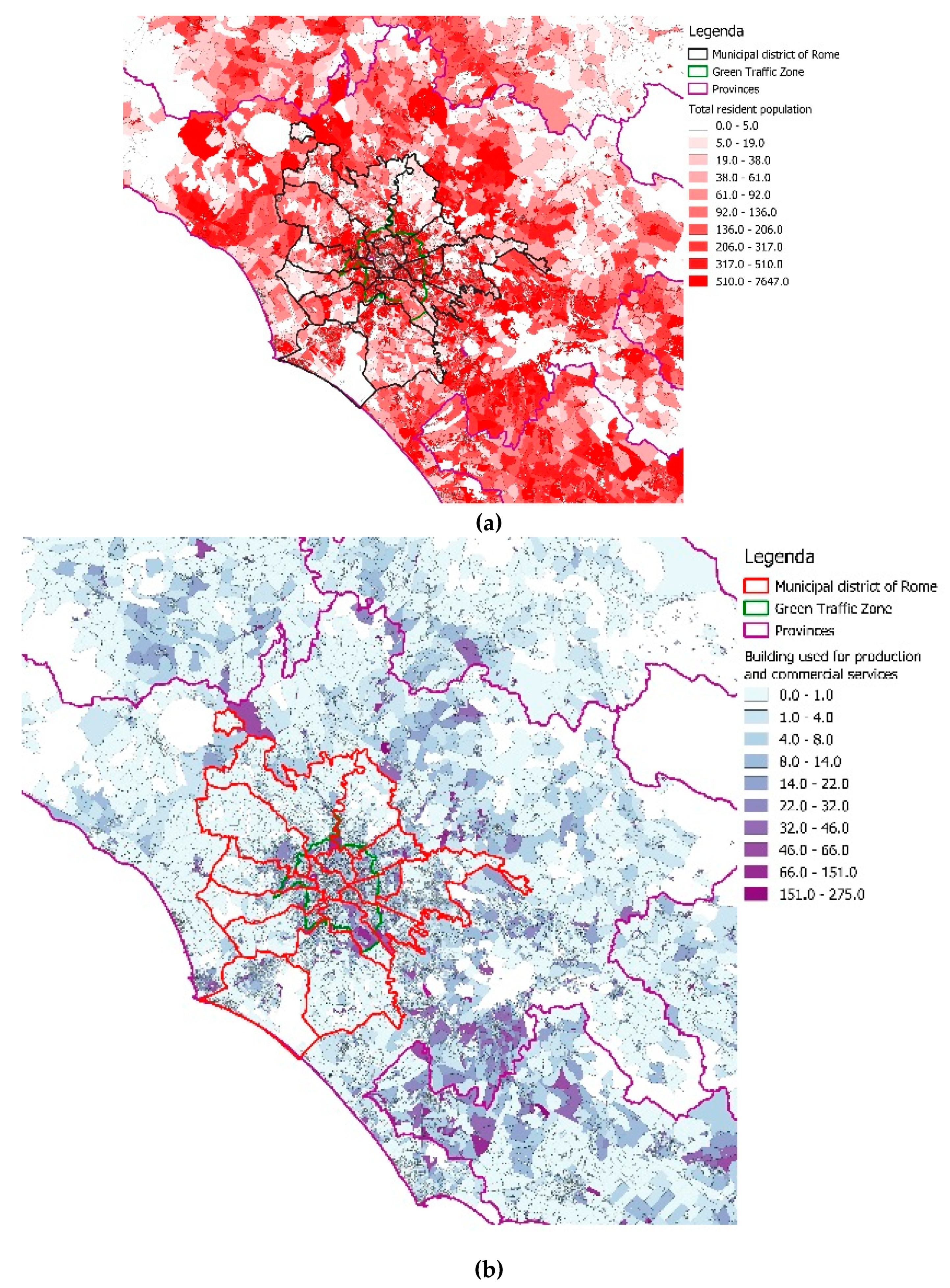
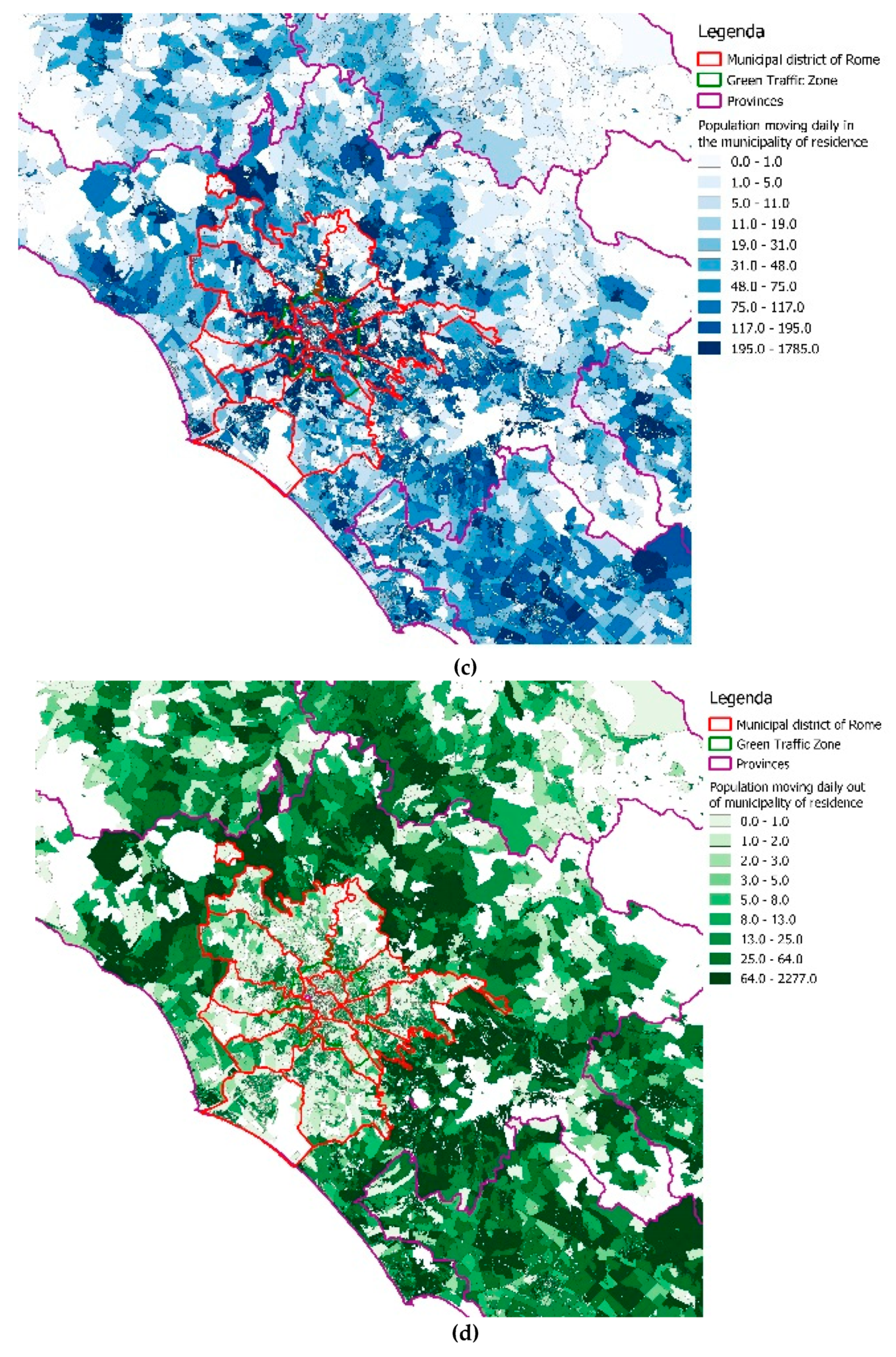
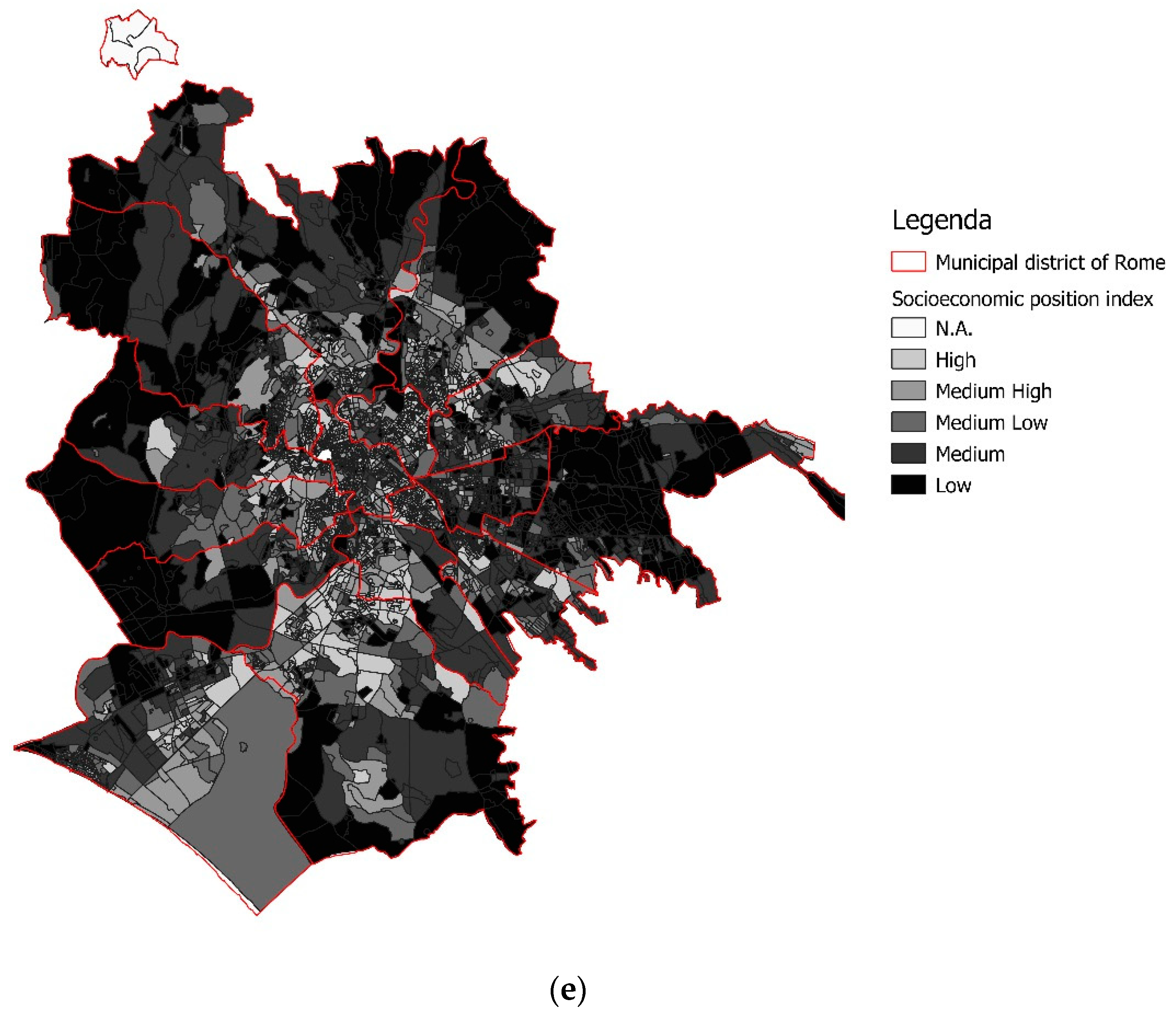
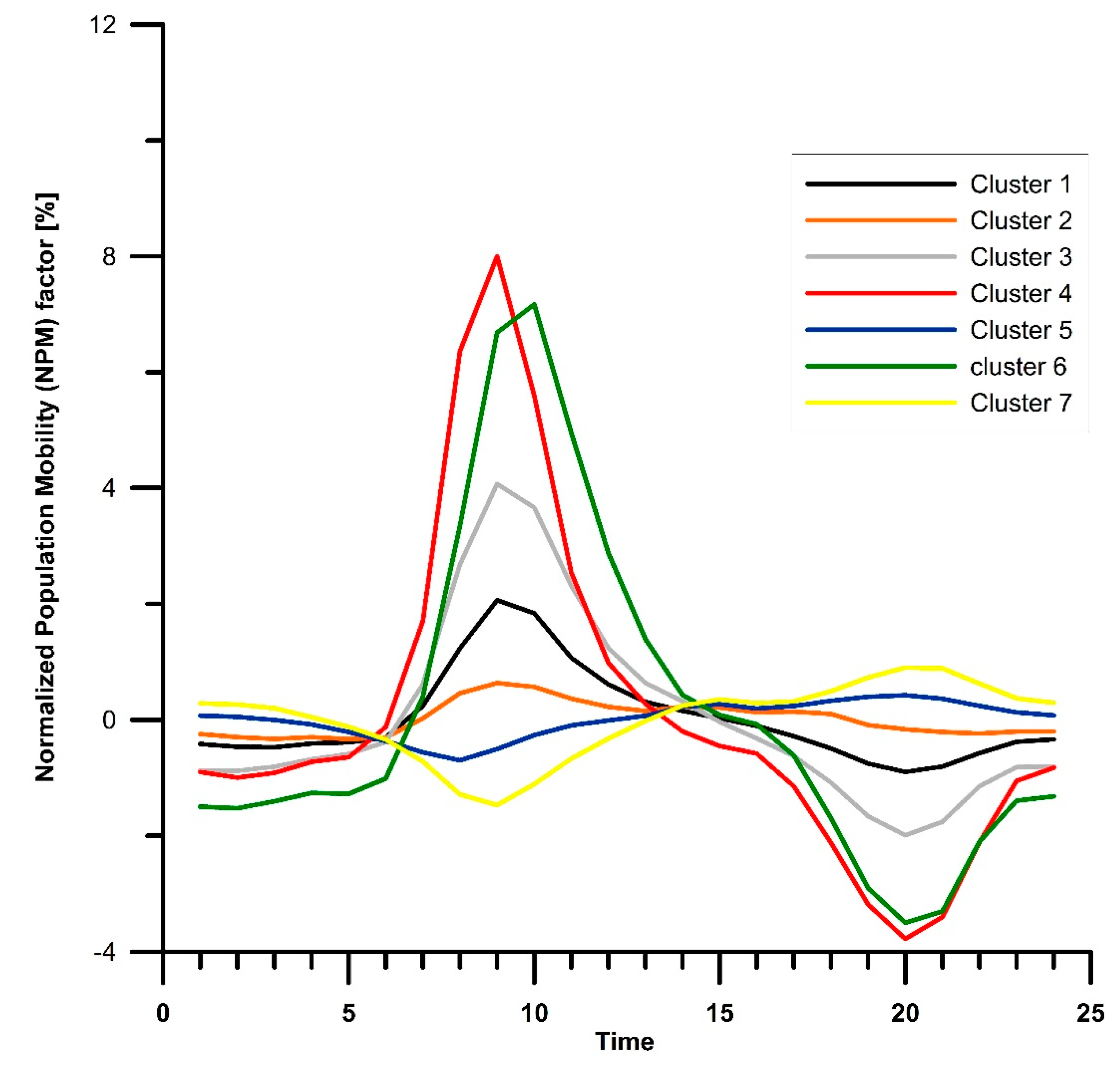
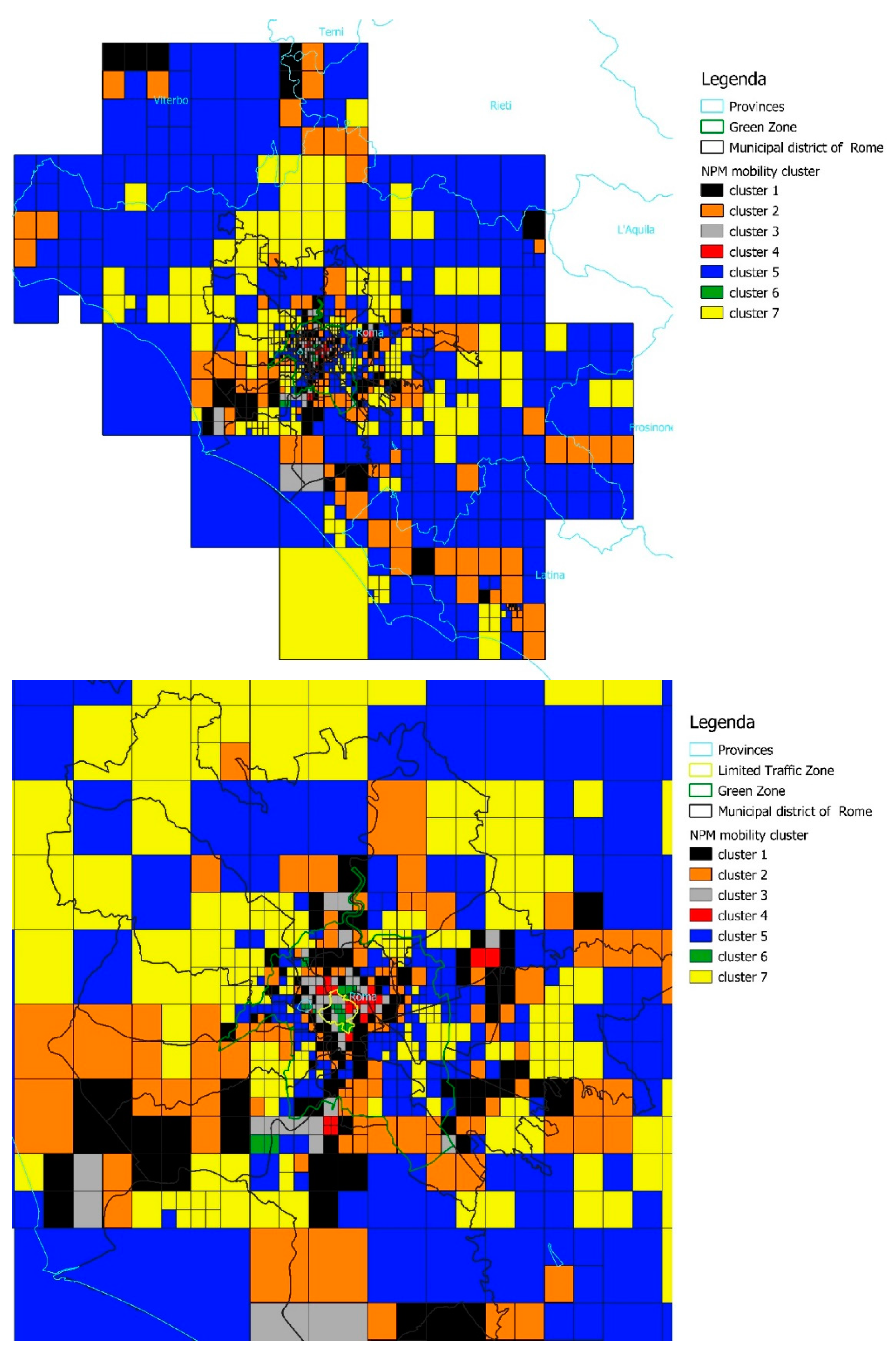
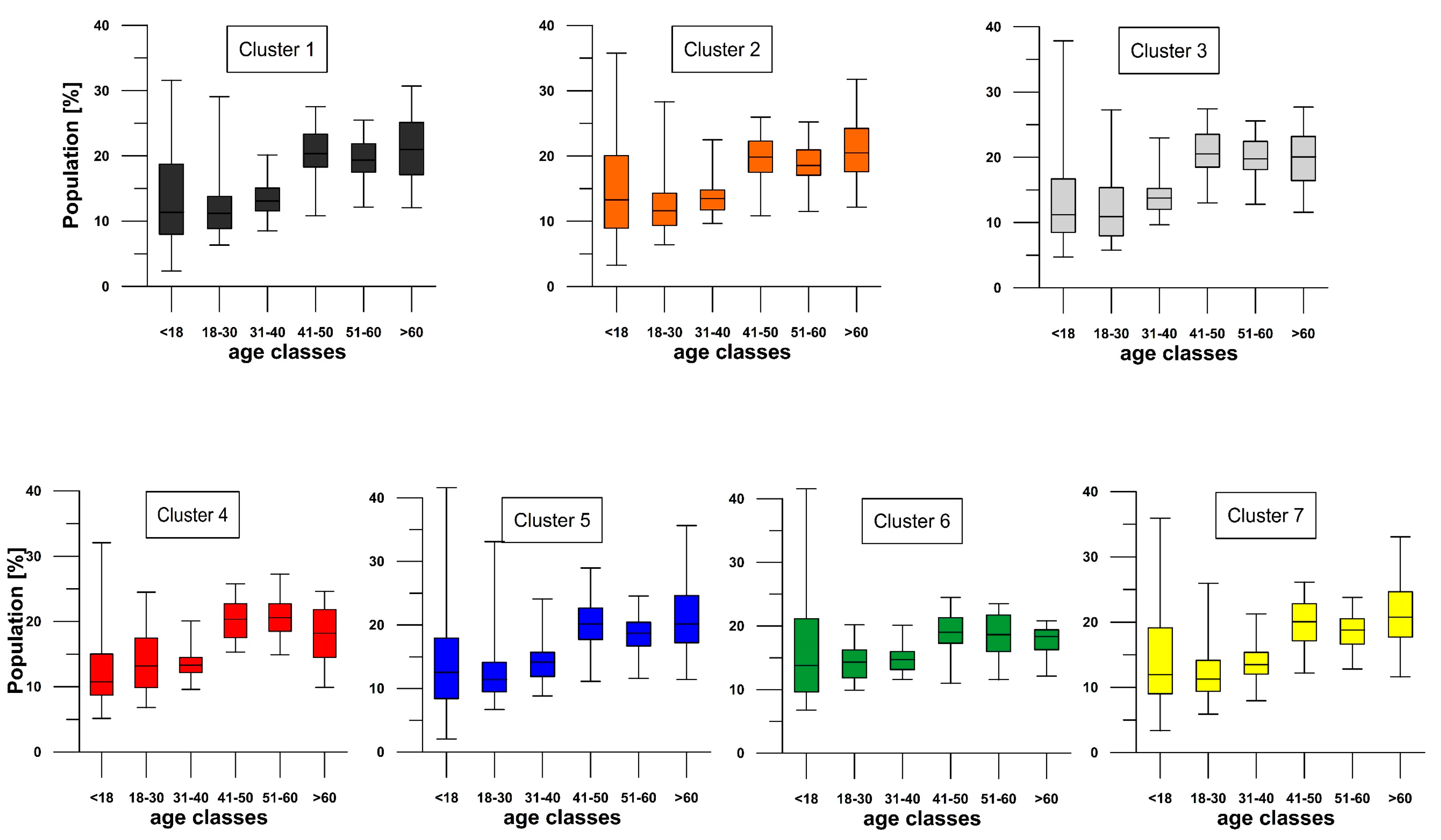
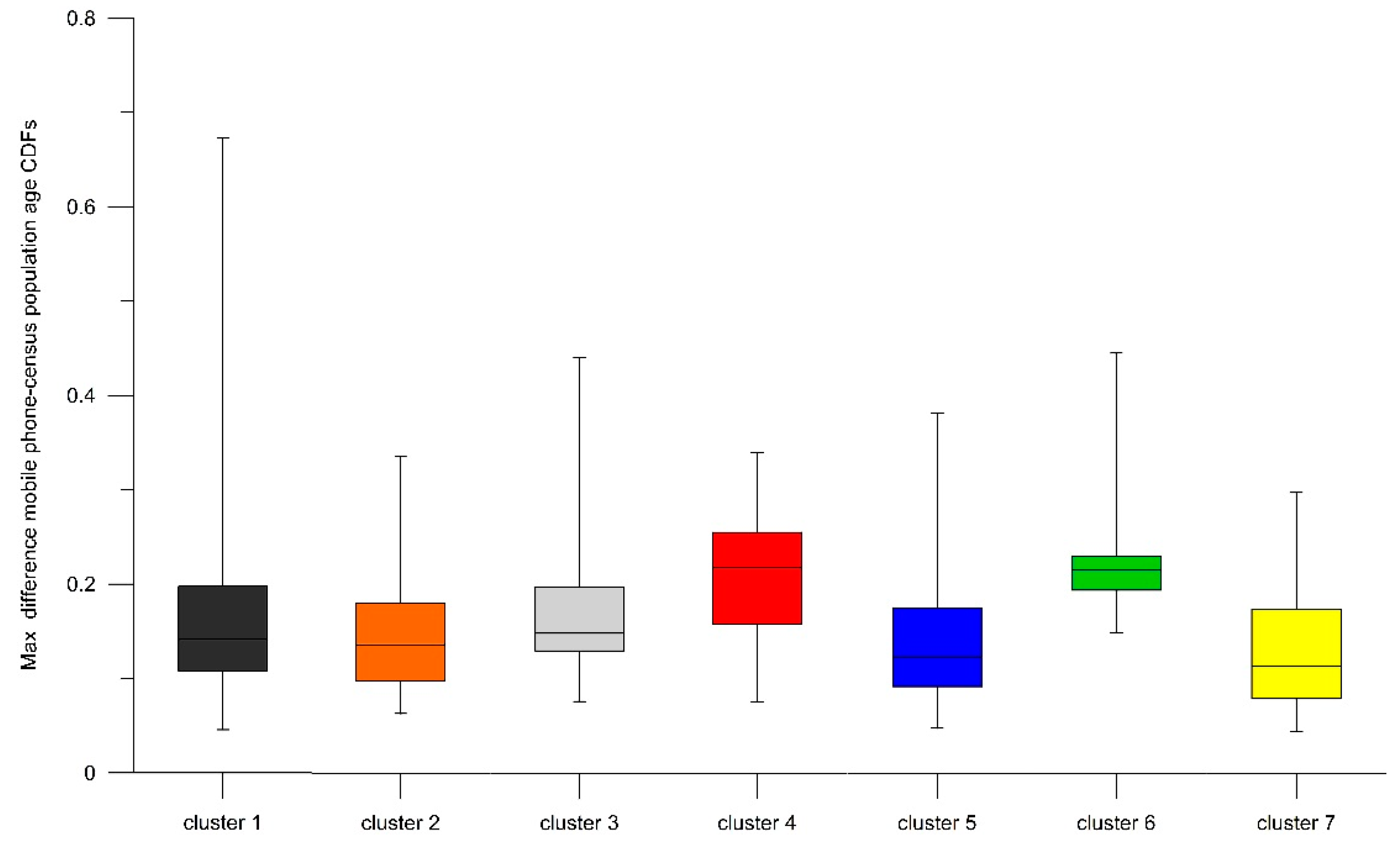
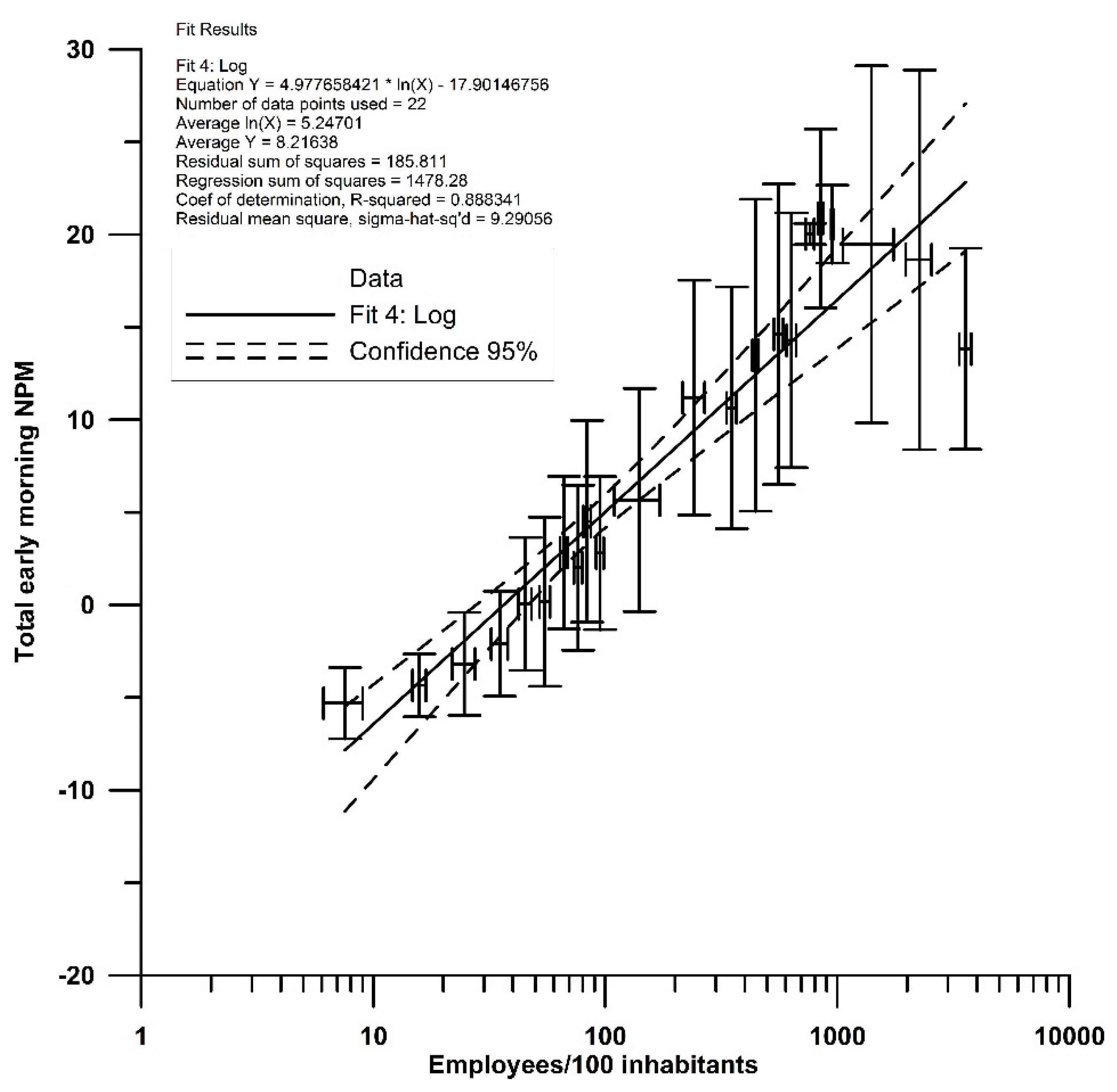
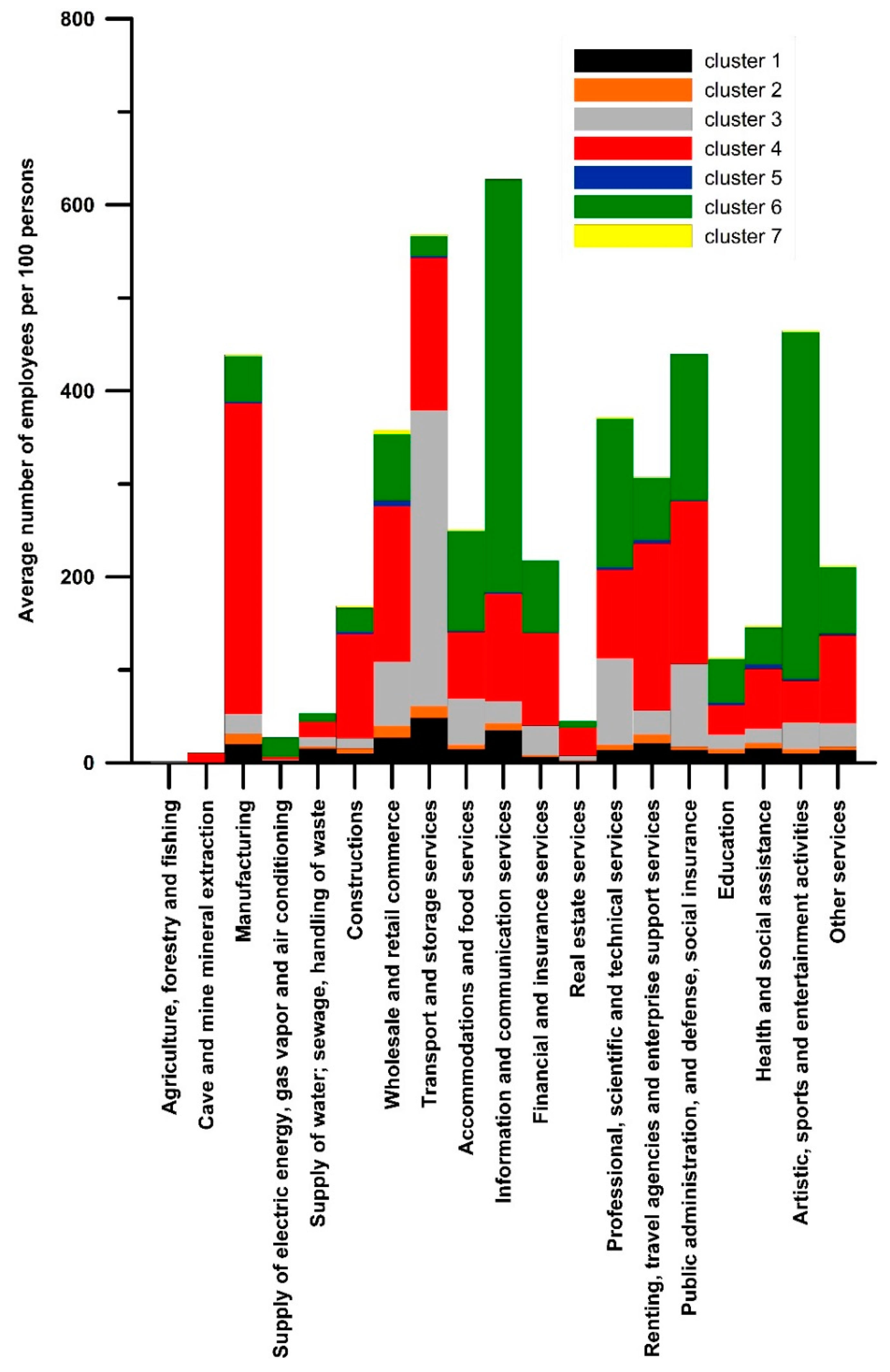
| Census 2011 Updated 2015 | Mobile Phone Traffic Based Population | Coverage [%] | |
|---|---|---|---|
| Rome and northern Latina provinces | 4.46 × 106 | 1.77 × 106 | 39.6 |
| Demography of Rome Municipality | |||
| <18 | 5.1 | 7.6 | |
| 18–30 | 11.1 | 10.1 | |
| 31–40 | 16.2 | 13.2 | |
| 41–50 | 19.7 | 23.0 | |
| 51–60 | 15.6 | 21.1 | |
| >60 | 32.4 | 25.0 |
| Exit Time | Trip Duration | |||||||
|---|---|---|---|---|---|---|---|---|
| <7:15 | 7:15–8:15 | 8:15–9:14 | >9:15 | <15 min | 16–30 min | 31–60 min | >60 min | |
| Rome | 30.5 | 44.2 | 17.7 | 7.7 | 28.4 | 28.6 | 29.5 | 13.5 |
| Population Moving within the Municipality of Residence [%] | Population Moving out the Municipality of Residence [%] | |
|---|---|---|
| Province of Rome | 40.0 | 9.5 |
| Province of Rome out of Rome’s Municipality | 25.2 | 23.3 |
| Municipality of Rome | 48.0 | 2.4 |
| Cluster | Land Use | Number of Cells |
|---|---|---|
| cluster-1 | Medium density commercial and services areas | 114 (12%) |
| cluster-2 | Low density commercial and services areas | 154 (17%) |
| cluster-3 | High density commercial and services areas | 50 (5%) |
| cluster-4 | High density business & services areas | 28 (3%) |
| cluster-5 | Residential & rural areas | 332 (36%) |
| cluster-6 | Touristic & commercial areas | 21 (2%) |
| cluster-7 | Residential areas | 228 (25%) |
| Cluster | Total Mean Early Morning NPM Mobility | Mean Number of Residential Buildings per km2 | Mean Number of Workplace Buildings per km2 | Residential to Workplace Buildings Ratio |
|---|---|---|---|---|
| cluster-7 | −5.59 | 251.82 | 44.46 | 5.66 |
| cluster-5 | −2.49 | 152.41 | 34.32 | 4.44 |
| cluster-2 | 1.74 | 135.39 | 45.61 | 2.97 |
| cluster-1 | 6.14 | 197.59 | 89.53 | 2.21 |
| cluster-3 | 12.95 | 305.15 | 152.34 | 2.00 |
| cluster-6 | 21.54 | 250.00 | 224.21 | 1.12 |
| cluster-4 | 24.07 | 195.50 | 193.35 | 1.01 |
© 2019 by the authors. Licensee MDPI, Basel, Switzerland. This article is an open access article distributed under the terms and conditions of the Creative Commons Attribution (CC BY) license (http://creativecommons.org/licenses/by/4.0/).
Share and Cite
Gariazzo, C.; Pelliccioni, A.; Bogliolo, M.P. Spatiotemporal Analysis of Urban Mobility Using Aggregate Mobile Phone Derived Presence and Demographic Data: A Case Study in the City of Rome, Italy. Data 2019, 4, 8. https://doi.org/10.3390/data4010008
Gariazzo C, Pelliccioni A, Bogliolo MP. Spatiotemporal Analysis of Urban Mobility Using Aggregate Mobile Phone Derived Presence and Demographic Data: A Case Study in the City of Rome, Italy. Data. 2019; 4(1):8. https://doi.org/10.3390/data4010008
Chicago/Turabian StyleGariazzo, Claudio, Armando Pelliccioni, and Maria Paola Bogliolo. 2019. "Spatiotemporal Analysis of Urban Mobility Using Aggregate Mobile Phone Derived Presence and Demographic Data: A Case Study in the City of Rome, Italy" Data 4, no. 1: 8. https://doi.org/10.3390/data4010008
APA StyleGariazzo, C., Pelliccioni, A., & Bogliolo, M. P. (2019). Spatiotemporal Analysis of Urban Mobility Using Aggregate Mobile Phone Derived Presence and Demographic Data: A Case Study in the City of Rome, Italy. Data, 4(1), 8. https://doi.org/10.3390/data4010008





